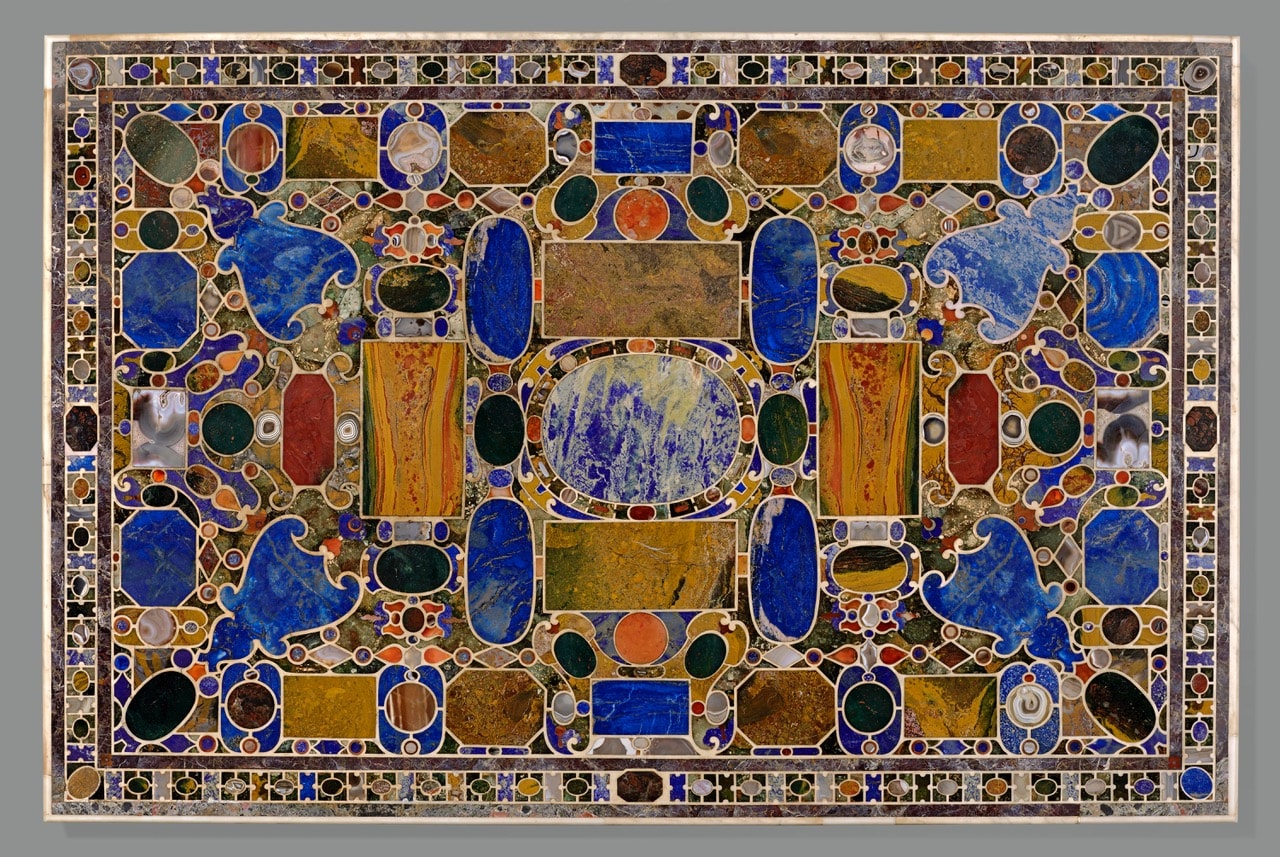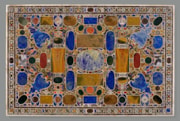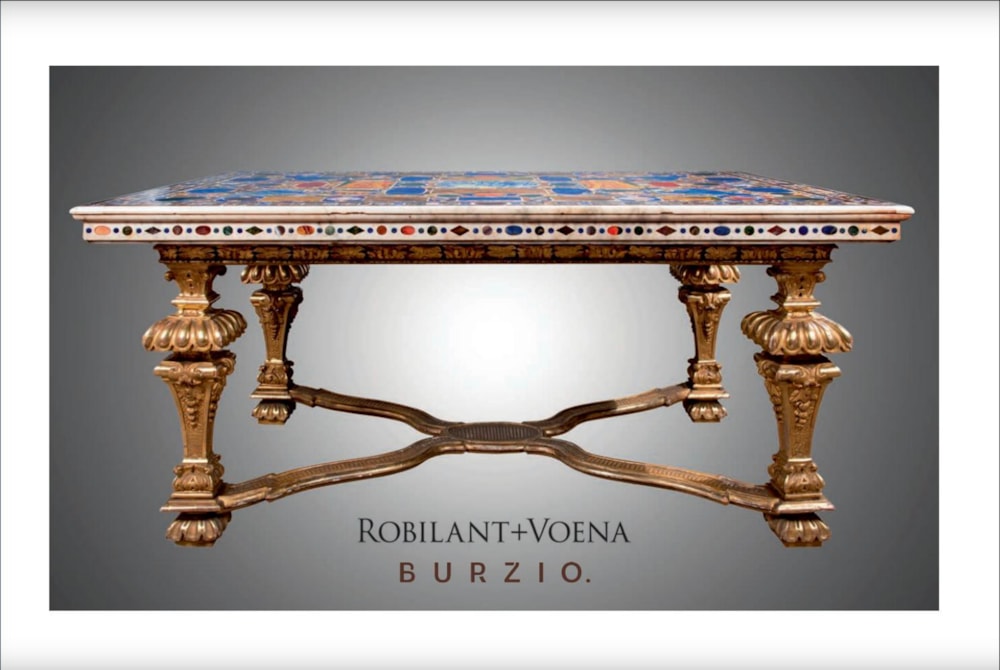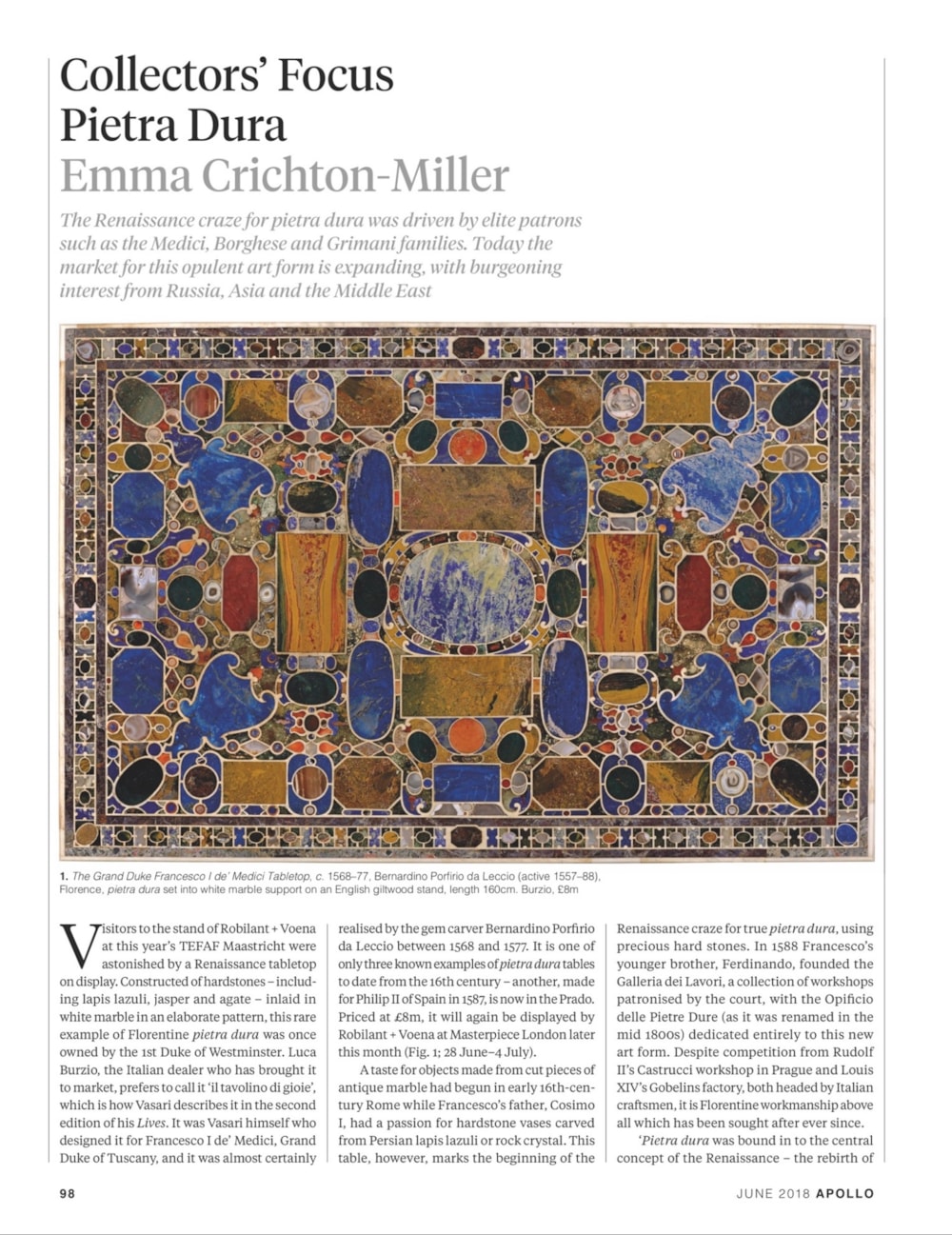

Bernardino Porfirio da Leccio
The Grand Duke Francesco I de’ Medici Table-Top, designed by Giorgio Vasari. Now in an important Asian public Collection .
Hardstones (Pietra Dura) set into a white marble support
Now on an English 17th century style giltwood stand
Length: 160 cm. (63 in.) Width: 107 cm. (42 ⅛ in.) Depth: 8 cm. (3 ⅛ in.) (the table top)
Length: 141.5 cm. (55 11/16 in.) Width: 87 cm. (34 ¼ in.) Height: 70.5 cm. (27 ¾ in.) (the stand)
Granducal Workshop at Casino di San Marco, Florence, 1568-1577
Provenance
https://issuu.com/artsolution/docs/tefaf-maastricht-gallery-brochure_f?e=6637020/65213670
Literature
Alvar González-Palacios, Mosaici e Pietre Dure, II. Firenze – Paesi Germanici – Madrid, Milan, 1982, p. 14 (ill.)
Filippo M. Tuena, ‘Cosimo I e le pietre dure’, in A. González-Palacios (ed.), Antologia di Belle Arti, Turin, 1990, p. 147 (ill.)
Alvar González-Palacios, Il Gusto dei Principi, vol. II, Milan, 1993, p. 361, ill. 703
Important Italian and French Furniture and Tapestries, Sotheby’s London, 15 December 1999, p. 46, fig. 3
Alvar González-Palacios, Las Colecciones Reales Españolas de Mosaicos y Piedras Duras, Madrid, 2001, p. 62 (ill.)
Anna Maria Giusti, Pietre Dure and the Art of Florentine Inlay, London, 2006, p. 29
Simon Swynfen Jervis and Dudley Dodd, Roman Splendour, English Arcadia: The English Taste for Pietre Dure and the Sixtus Cabinet at Stourhead, London, 2015, p. 50
The Journal of the Furniture History Society. Volume VI for the year 2020. The Alexandrine table by Simon Swinfen Jervis. Pag.84-85 Figure 2.pag.104 note 8.
Bollettino d'Arte.N.47-48. July-December 2020.Enrico Colle, Un "tavolino di gioje" per Francesco de Medici. Pag. 119..124 Note 8.
COMPARATIVE LITERATURE
Giorgio Vasari, Le vite de' più eccellenti pittori, scultori et architetti, vol. 3, Florence, 1568 Ulisse Aldrovandi, Itinerarium Florentiae, 1586, unpublished manuscript, Bologna University Library, MS 136/11
John Fleming, ‘Art Dealing in the Risorgimento II’, The Burlington Magazine, vol. 121, no. 917 (Aug., 1979), pp. 492-494+497-500+502-508
John Fleming, ‘Art Dealing in the Risorgimento III’, The Burlington Magazine, vol. 121, no. 918 (Sep., 1979), pp. 568-573+575-580
Nicolas Audebert, Voyage d'Italie, Adalberto Olivero (ed.), vol. 1, Rome, 1981
Filippo M. Tuena, ‘Appunti per la storia del commesso romano: Il 'franciosino' maestro di tavole del cardinale Giovanni Ricci’, in A. González-Palacios (ed.), Antologia di Belle Arti, Rome, 1988, pp. 54-69
Suzanne B. Butters, ‘”Una pietra eppure non una pietra”: pietre dure e le botteghe medicee nella Firenze del Cinquecento’, in G. Fossi and F. Franceschi (eds.), La Grande Storia dell’Artigianato, III: Il Cinquecento, Florence, 2000, pp. 133-185
Maria Alberta Zuffanelli, ‘L'Opificio delle pietre dure e le sue diverse sedi: trasferimenti e vicende costruttive dal secolo XVI al secolo XIX’, OPD Restauro, no. 17 (2005), pp. 317-332
Anna Maria Giusti, ‘“La pietra non mai abbastanza lodata” nella manifattura Granducale di Firenze’, in V. Conticelli et al. (eds.), Lapislazzuli, Magia del Blu, exh. cat., 9 June – 11 October 2015, Museo degli Argenti and Museo di Storia Naturale, Florence, Livorno, 2015, pp. 101-109
Detail Description
"His Excellency [Francesco] has also caused a beginning to be made with the executing of a table with precious stones, richly adorned, as an accompaniment to another belonging to his father, Duke Cosimo, finished not long ago after the design of Vasari, which is a rare work, being of oriental alabaster all inlaid with great pieces of jasper, heliotrope, cornelian, lapis lazuli, and agate, with other stones and jewels of price that are worth twenty thousand scudi. This table was executed by Bernardino di Porfirio of Leccio in the neighbourhood of Florence, who is excellent in such work, and who made for Messer Bindo Altoviti an octagonal table of ebony and ivory inlaid likewise with jaspers, after the design of the same Vasari; which Bernardino is now in the service of their Excellencies."
Giorgio Vasari, Le vite de' più eccellenti pittori, scultori et architetti, vol. 3, Florence, 1568
Print Format
Additional images










